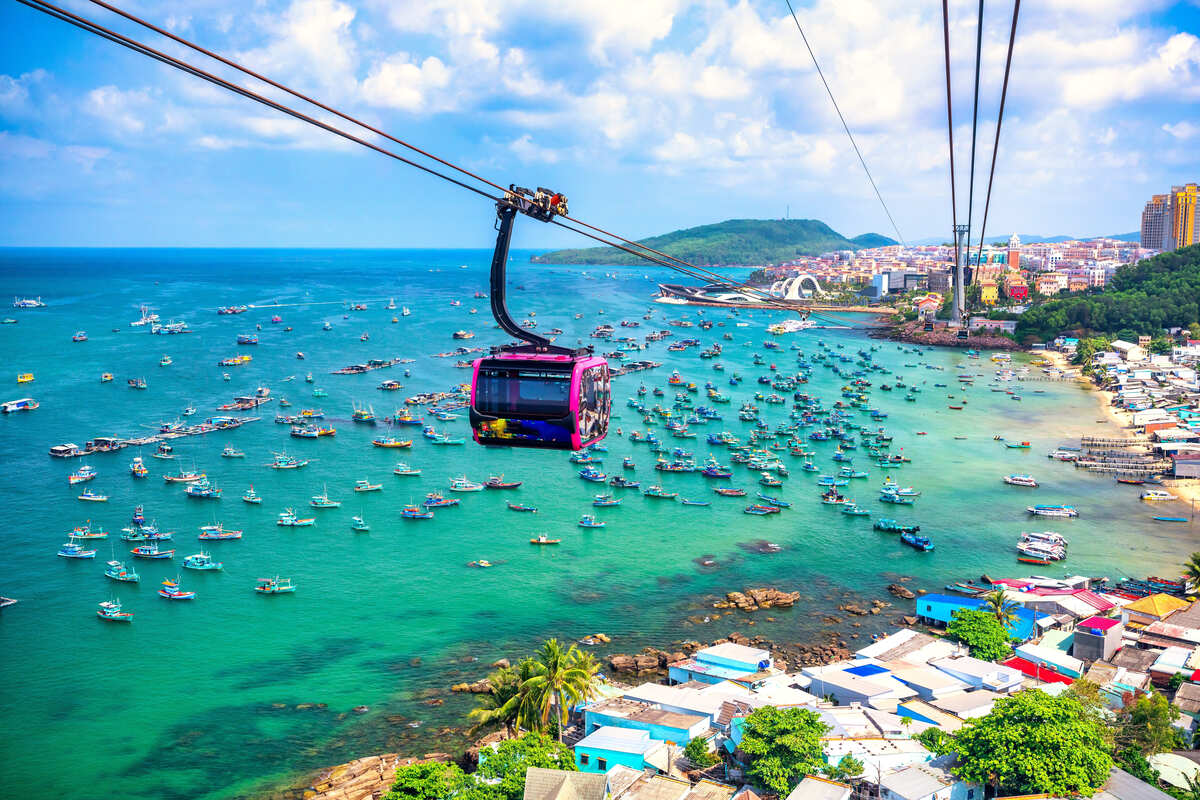
Move Over Phuket: This Vietnamese Gem Has Just Been Voted Best Island In Southeast Asia
Bali and Phuket may be two of the most popular island destinations in Southeast Asia, thanks to their beautiful nature, world-famous beaches and lively social scene, but according to Travel & Leisure, they’re far from being the subcontinent’s finest offer.


Every year, Travel & Leisure announces their World’s Best Awards, with different destinations ranked based on their tourist offer, quality of service, value for money, among other factors, and Southeast Asia’s tropical gems are no exception.
Still, it may have been a surprise to some that the best local island is the lesser-known Phu Quoc, part of Vietnam: not only does it rank the highest among Southeast Asian entries, but it places second worldwide after the Maldives.
Now, in case you’ve been wondering how this offbeat spot could fence off Thailand’s party capital, and Indonesia’s wellness haven, we’re here to tell you 5 of the main reasons why:
The Beautiful Nature


Southeast Asia is synonymous with sparkling beaches, tropical jungles, and otherworldly nature vistas, and Phu Quoc is no exception: covering an area of 227.52 square miles, 86 percent of the fairly sizable island is, in fact, covered by lush, evergreen forest.
The so-called Phu Quoc National Park, part of a UNESCO-listed reserve, is a mountainous terrain traversed by hiking trails leading up to steep peaks, most famously Mount Chua, the tallest point on the island, and sprinkled with scenic waterfalls and natural water reserves.


Booking the full-day Private Guided Tour of Phu Quoc, starting from $48, you’ll get to tick off several of the park’s highlights, including the towering Suoi Tranh Waterfall and the idyllic Bai Tam Sao Beach, with its soft, sugar-white sands lapped by crystal-clear waters.
For the more adventurous visitors who are into trekking, the $53 Tien Son Dinh circuit is a great pick, running for a length of 3.7 miles through the Phu Quoc jungle and even some relaxation time at the Suoi Tranh natural spring.
The Laid-Back Island Living


Phu Quoc is also known for its laid-back living, small fishing villages lining an azure ocean, and centuries-old traditions; in other words, it’s not somewhere you come necessarily to party.
The local nightlife is rather tame compared to Phuket, though you’ll always find a foreigner-friendly bar or two in Duong Dong, the main town, and if you’re keen on escaping fellow Westerners, gentrification isn’t nearly as big a problem here as it has become in Bali.
Many of the villages around Phu Quoc are still untouched by mass development, particularly those located further away from the main theme parks and hotel zones, and it’s just the perfect destination for experiencing Vietnamese culture at its most authentic:


There’s An Thoi, with its fish sauce factories and sprawling markets offering a wide selection of seafood, fruit, and vegetables; the largely undisturbed Ganh Dau, bordering a peaceful stretch of beach; and the picturesque Ham Ninh, a tiny village still mostly inhabited by fishermen.
Compared to the Vietnamese mainland, Phu Quoc has no hugely important heritage sites, beautiful colonial architecture, or imperial citadels built in the nation’s heyday: it’s mostly a very laid-back rural island, and that’s where its charm lies.
If you’re flying to Phu Quoc, however, chances are VinWonders is high on your bucket list:
The Home Of Vietnamese Disney


Perhaps the main reason most tourists come to Phu Quoc is that it is home to VinWonders, the most monumental leisure destination in Vietnam.
This super complex of about 50 hectares encompasses theme parks, malls, hotels, and entertainment centers.
Clearly modeled after Disneyland––it even has a shop-lined avenue leading to a fairytale castle––VinWonders is open daily from 9 a.m. to 7:30 p.m. and it’s a must-see attraction on the island, offering thrilling adventures for the entire family.


Main points of interest include the Mysterious Viking Village (for those who are not afraid to get wet), Magical Venice, a more colorful, kitsch reconstruction of Italy’s iconic Floating City (except catching a gondola here costs a small fraction of the price), and our favorite, the Hon Thom:
One of the park’s most sought-after activities, this cable car stretches for nearly 5 miles, making it the longest sea-crossing of its kind in the world.
It links the southern tip of Phu Quoc to the neighboring Pineapple Island, an oasis of tranquility fringed by teal-colored waters.


The best part is tickets to VinWonders Phu Quoc typically start from VND 950,000 per adult, or around $37.52 based on the current conversion rate––shall we remind you how much Disney day tickets in Orlando or California are, again?
The Incomparable Affordability
Finally, affordability plays a key role in Phu Quoc’s attractiveness, especially when paired with Bali, Phuket, and the like, where room rates have increased steadily over the years and tourist activities have become progressively more expensive.


If you’re visiting Phu Quoc as a backpacker on a budget, you can find hotel rooms, AC included, for only $16 at the Luxy Park Hotel, just outside Duong Dong, and even an entire bungalow at Dugong Resort, near Ham Ninh, will only set you back by $20 per night.
Now, for those of you who feel like splurging a little, after all, Vietnam is dirt-cheap for Americans, the five-star Ocean Bay Phu Quoc Resort and Spa has nightly rates starting from $98, including continental breakfast, an outdoor pool, and a private beach.


Resort stays in Phu Quoc go as cheap as $42 a night in Phu Quoc this season, easily making it one of the most affordable tropical destinations in the world––honestly, a trip to the island is as expensive as you make it.
Based on estimates provided by Vinpearl, the leading hospitality and entertainment brand on the island, a solo trip to Phu Quoc can cost a negligible VND 5,000,000, or $197.49, if you’re staying in inexpensive hotels and eating local.


Food is particularly cheap, with Ken noodles costing less than a dollar in local restaurants, the signature Ham Ninh crab averaging VND 180,000 in inexpensive eateries, or roughly $7.11 at the current exchange rate, and even the popular herring salad is $5.92.
Vinpearl notes these values are for reference only, as expenses can vary depending on different traveling styles.
The Visa-Free Access
Last but certainly not least, Phu Quoc is a visa-free island to visit.


Unlike most Asian countries, where foreigners must purchase tourist visas upon arrival or even apply for travel authorization in advance, they can fly to Phu Quoc requirement-free only by presenting a valid passport, as long as their stay does not exceed 30 days.
Phu Quoc operates a different visa regime than the rest of Vietnam, where U.S. passport holders cannot travel without obtaining an e-Visa in advance, making it rather appealing to the bureaucracy-wary visitor who just can’t be doing with the formality of visa applications and online forms.
At the end of the day, it’s not really a surprise that T&L readers have named it the Best Island in Southeast Asia.
↓ Elevate Your Travel↓
Sign Up Now For Travel Off Path Premium! No ads, VIP Content, Personal Travel Concierge, Huge Savings, Daily Deals, Members Forum & More!


✈️Join Our Travel Off Path Community Forum: Where travelers unite, ask questions, share experiences and even find like-minded travel buddies!
SUBSCRIBE TO OUR LATEST POSTS
Enter your email address to subscribe to Travel Off Path’s latest breaking travel news, straight to your inbox.
This article originally appeared on TravelOffPath.com
Opinions expressed here are the author’s alone, not those of any bank, credit card issuer, hotel, airline, or other entity. This content has not been reviewed, approved or otherwise endorsed by any of the entities included within the post.
